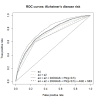Common polygenic variation enhances risk prediction for Alzheimer's disease
- PMID: 26490334
- PMCID: PMC5006219
- DOI: 10.1093/brain/awv268
Common polygenic variation enhances risk prediction for Alzheimer's disease
Abstract
The identification of subjects at high risk for Alzheimer's disease is important for prognosis and early intervention. We investigated the polygenic architecture of Alzheimer's disease and the accuracy of Alzheimer's disease prediction models, including and excluding the polygenic component in the model. This study used genotype data from the powerful dataset comprising 17 008 cases and 37 154 controls obtained from the International Genomics of Alzheimer's Project (IGAP). Polygenic score analysis tested whether the alleles identified to associate with disease in one sample set were significantly enriched in the cases relative to the controls in an independent sample. The disease prediction accuracy was investigated in a subset of the IGAP data, a sample of 3049 cases and 1554 controls (for whom APOE genotype data were available) by means of sensitivity, specificity, area under the receiver operating characteristic curve (AUC) and positive and negative predictive values. We observed significant evidence for a polygenic component enriched in Alzheimer's disease (P = 4.9 × 10(-26)). This enrichment remained significant after APOE and other genome-wide associated regions were excluded (P = 3.4 × 10(-19)). The best prediction accuracy AUC = 78.2% (95% confidence interval 77-80%) was achieved by a logistic regression model with APOE, the polygenic score, sex and age as predictors. In conclusion, Alzheimer's disease has a significant polygenic component, which has predictive utility for Alzheimer's disease risk and could be a valuable research tool complementing experimental designs, including preventative clinical trials, stem cell selection and high/low risk clinical studies. In modelling a range of sample disease prevalences, we found that polygenic scores almost doubles case prediction from chance with increased prediction at polygenic extremes.
Keywords: Alzheimer’s disease; polygenic score; predictive model.
© The Author (2015). Published by Oxford University Press on behalf of the Guarantors of Brain. All rights reserved. For Permissions, please email: journals.permissions@oup.com.
Figures



References
Publication types
MeSH terms
Substances
Grants and funding
- P30 AG010124/AG/NIA NIH HHS/United States
- MR/L023784/1/MRC_/Medical Research Council/United Kingdom
- U24 AG021886/AG/NIA NIH HHS/United States
- MR/L501517/1/MRC_/Medical Research Council/United Kingdom
- MR/K013041/1/MRC_/Medical Research Council/United Kingdom
- G0902227/MRC_/Medical Research Council/United Kingdom
- R01 AG008122/AG/NIA NIH HHS/United States
- R01 AG033193/AG/NIA NIH HHS/United States
- 164/ALZS_/Alzheimer's Society/United Kingdom
- MR/M009076/1/MRC_/Medical Research Council/United Kingdom
- U01 AG049505/AG/NIA NIH HHS/United States
- MR/L501529/1/MRC_/Medical Research Council/United Kingdom
- MC_U123160651/MRC_/Medical Research Council/United Kingdom
- U01 AG032984/AG/NIA NIH HHS/United States
- 167/ALZS_/Alzheimer's Society/United Kingdom
- MR/L023784/2/MRC_/Medical Research Council/United Kingdom
- MR/L010305/1/MRC_/Medical Research Council/United Kingdom
LinkOut - more resources
Full Text Sources
Other Literature Sources
Medical
Miscellaneous

